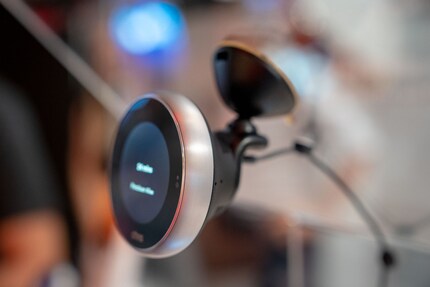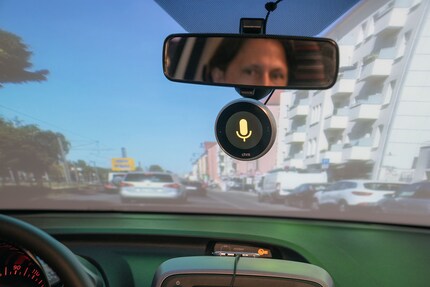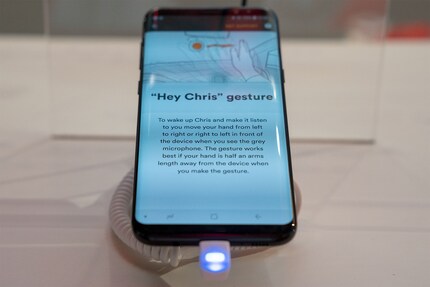
News + Trends
Samsung at MWC - all guns blazing on fibre optics, 5G and the Internet of Things
by Dominik Bärlocher
World première: a German start-up is presenting a smart passenger at the IFA. The small device on the rear-view mirror is called Chris and controls music, navigation and communication.
One thing is being emphasised at the IFA in Berlin this year: AI, artificial intelligence. As soon as a computer thinks something through or talks to something else, it is AI. The German start-up German Autolabs is joining this series with Chris. The smart hemisphere was presented as a world premiere at the IFA last Friday.
Chris is making a name for itself by being affordable and flexible. The digital co-driver, as the company calls him, can be installed in any car. Chris is not the only smart passenger at the IFA. Samsung is showing a BMW that fits seamlessly into Smart Things. This means that the car can tell the oven at home to preheat when you leave the office. The problem: you have to buy a new BMW for this. Not everyone can do that.

Chris is still a long way from talking to anything in your home. "Chris is there to make driving easier and not distract you from the traffic," says Holger Weiss, co-founder of German Autolabs. Therefore, integration into a smart home ecosystem is not a priority.
Chris is a round object that talks to you in a woman's voice. You attach it either under your rear-view mirror or in the centre of your dashboard in the car. A Linux distro runs on the hemisphere, which is designed to attract as little attention as possible. Chris uses gestures and voice commands.

"Hey Chris" begins a command sequence. The device understands German and English. Other languages will be added later. Adding a language only takes a few weeks, except for Chinese. That would take longer. The microphone pictogram changes from grey to yellow. Chris is listening.
"Play music" starts the audio player. An audio player appears on the display, which is visually quite uninteresting. A mini view of the album cover and then some text underneath. So far, Chris has only played music stored locally on a smartphone connected via Bluetooth. In the demo, this is "The Now Now" by the Gorillaz.
The track "Humility" starts to play. But if you don't like the track, you can simply move your hand in the air from right to left and Chris skips to the next song. From left to right changes from "Tranz" back to "Humility". You can make it louder by holding your hand up and pulling it back. For quieter, push the air from behind towards Chris.
A camera system in the hemisphere - named after St Christopher, the patron saint of travellers - recognises your movements and interprets them. The system works in a similar way with calls or text messages or navigation, which selects cloud-based routes and sorts them according to the current traffic situation. WhatsApp is not yet integrated, but will be soon.
Chris is not yet particularly intelligent. If you dictate a text message to the female voice, we say "Hello, team digitec! How are you?", then you have to say something like "Hello comma team digitec exclamation mark How are you question mark" in the car. Chris is still a long way from understanding text like Amazon's Alexa, Siri or Google's Assistant. The voice playback also still sounds robotic. However, the device works offline. In Switzerland, this is valuable in rural areas or on mountain roads with all their tunnels.
But it doesn't always have to stay that way. In the German Autolabs, developers are working on new features such as WhatsApp integration. "The text is simple, but we are still working on making emojis pronounceable and logical," says Weiss. Other languages, app integrations and other features to help the driver are also planned.

Since the hemisphere in the car does very little computing itself, but uses the computing power of the smartphone, both the app and the hardware can simply be updated with the apps. This is probably the smartest move in German Autolabs' two-year company history to date: the entire system is not hardware-based. Rather, it is a peripheral device that essentially only collects data, forwards it and then spits out interpreted data. This interpretation takes place on the smartphone. This means that the hardware of the hemisphere is kept simple and focusses on communication via Bluetooth 4.2. This means that the technological thrust of German Autolabs is not so far removed from that of smartphones.
The reason why features are being omitted is not because the Chris developers can't do it. "We're really just concentrating on the journey in the car," says Weiss. Because he wants the distractions behind the wheel to be fewer, not more. That's why Chris is visually unobtrusive. That's why Chris can't talk to the microwave at home. Because behind the wheel, you shouldn't receive notifications from a weather report or see large flashing displays. You're supposed to be looking at the road, not texting. Keep an eye on the flow of traffic, not watch an animation of a rain cloud. That is the mission of German Autolabs.
"Chris is a living system," says Weiss, "and features will be added bit by bit."
At the German Autolabs stand in Hall 26 of the Berlin IFA, we are told that Chris will also be available in Switzerland. The language problem could be solved with enough hard work, because in Switzerland it is difficult or even impossible to distribute a product widely if it does not speak German, French and Italian.
The problem, as I and video producer Stephanie Tresch were told at the stand, lies in the regulations that prohibit interference in the field of vision while driving. The question that remains unanswered: Is Chris violating these regulations? Or to put it another way: is Chris legal in Switzerland?
Internationally, however, demand is high. Holger Weiss and his team at the stand are aware of the complexity of a Chinese language solution, as they have been asked several times by Chinese businesspeople whether and how Chris will come to China. To this end, the two-year-old company German Autolabs financed Chris via Kickstarter. Autolabs wanted 50,000 euros, they got 278,720 euros.
In short: Chris is a clever little machine with a lot of potential. Judging by the staff at the stand, the device is definitely one that you should keep an eye on if you are a frequent driver and that could well compete with TomTom and co. <p
Journalist. Author. Hacker. A storyteller searching for boundaries, secrets and taboos – putting the world to paper. Not because I can but because I can’t not.